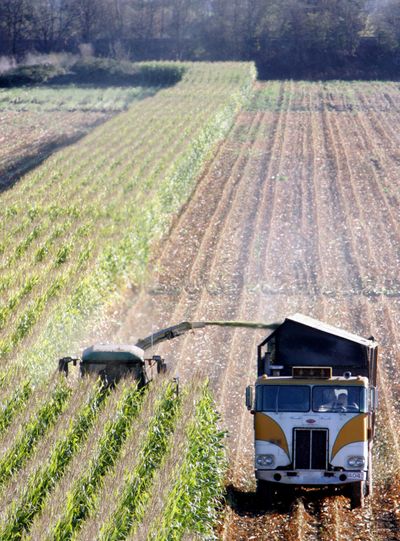Pest evolves to eat modified corn crop
Plant that lowered farmers’ pesticide use is now at risk

One of the nation’s most widely planted crops – a genetically engineered corn plant that makes its own insecticide – may be losing its effectiveness because a major pest appears to be developing resistance more quickly than scientists expected.
The U.S. food supply is not in any immediate danger because the problem remains isolated. But scientists fear potentially risky farming practices could be blunting the hybrid’s sophisticated weaponry.
When it was introduced in 2003, so-called Bt corn seemed like the answer to farmers’ dreams: It would allow growers to bring in bountiful harvests using fewer chemicals because the corn naturally produces a toxin that poisons western corn rootworms. The hybrid was such a swift success that it and similar varieties now account for 65 percent of all U.S. corn acres – grain that ends up in thousands of everyday foods such as cereal, sweeteners and cooking oil.
But over the last few summers, rootworms have feasted on the roots of Bt corn in parts of four Midwestern states, suggesting that some of the insects are becoming resistant to the crop’s pest-fighting powers.
Scientists say the problem could be partly the result of farmers who’ve planted Bt corn year after year in the same fields.
Most farmers rotate corn with other crops in a practice long used to curb the spread of pests, but some have abandoned rotation because they need extra grain for livestock or because they have grain contracts with ethanol producers. Other farmers have eschewed the practice to cash in on high corn prices, which hit a record in June.
“Right now, quite frankly, it’s very profitable to grow corn,” said Michael Gray, a University of Illinois crop sciences professor who’s tracking Bt corn damage in that state.
A scientist recently sounded an alarm throughout the biotech industry when he published findings concluding that rootworms in a handful of Bt cornfields in Iowa had evolved an ability to survive the corn’s formidable defenses.
Seed maker Monsanto Co. created the Bt strain by splicing a gene from a common soil organism called Bacillus thuringiensis into the plant. The natural insecticide it makes is considered harmless to people and livestock.
Scientists always expected rootworms to develop some resistance to the toxin produced by that gene. But the worrisome signs of possible resistance have emerged sooner than many expected.
The Environmental Protection Agency recently chided Monsanto, declaring in a Nov. 22 report that it wasn’t doing enough to monitor suspected resistance among rootworm populations. The report urged a tougher approach, including expanding monitoring efforts to a total of seven states, including Colorado, South Dakota and Wisconsin. The agency also wanted to ensure farmers in areas of concern begin using insecticides and other methods to combat possible resistance.
Monsanto insists there’s no conclusive proof that rootworms have become immune to the crop, but the company said it regards the situation seriously and has been taking steps that are “directly in line” with federal recommendations.
Some scientists fear it could already be too late to prevent the rise of resistance, in large part because of the way some farmers have been planting the crop.
They point to two factors: farmers who have abandoned crop rotation and others who have neglected to plant non-Bt corn within Bt fields or in surrounding fields as a way to create a “refuge” for non-resistant rootworms in the hope they will mate with resistant rootworms and dilute their genes.
Experts worry that the actions of a few farmers could jeopardize an innovation that has significantly reduced pesticide use and saved growers billions of dollars in lost yields and chemical-control costs.
“This is a public good that should be protected for future generations and not squandered too quickly,” said Gregory Jaffe, biotechnology director at the Center for Science and Public Policy.